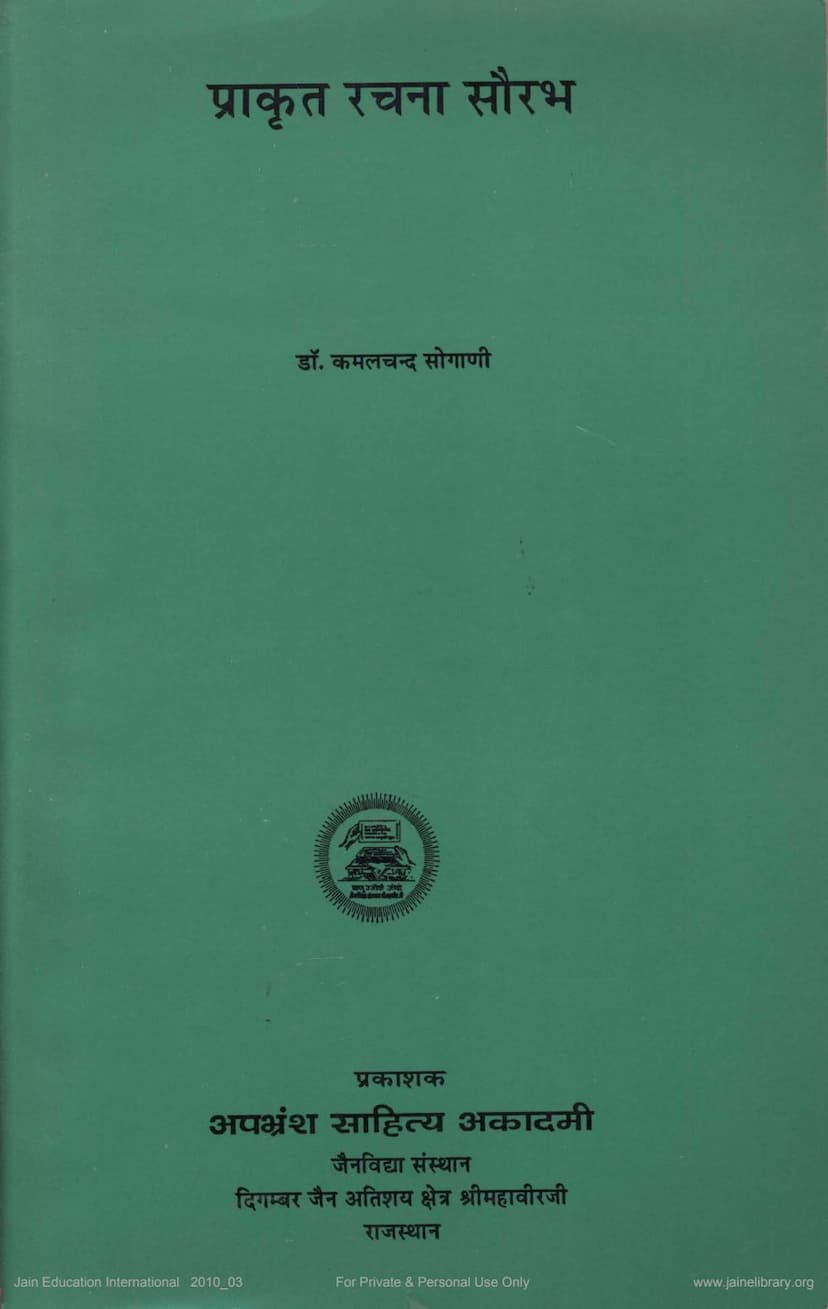Prakrit Rachna Saurabh
Added to library: September 2, 2025

Summary
This document is the "Prakrit Rachna Saurabh" by Dr. Kamalchand Sogani, published by Apbhramsa Sahitya Academy in 2010. The book is dedicated to the memory of Dr. Adinath Nemnath Upadhye, Dr. Nemichandra Shastri, and Pandit Becherdas Doshi.
The book is a comprehensive guide to learning and composing in the Prakrit language, a significant language in Indian history and literature, particularly for its role in Jain religious teachings and its evolution into Apabhramsa and subsequent regional languages like Hindi. The author emphasizes the importance of studying Prakrit for a deeper understanding of Apabhramsa and comparative linguistics.
Key aspects covered in the book, as indicated by the detailed table of contents, include:
- Introduction to Prakrit: Basic information about the language, including its alphabet, numbers of vowels and consonants, and the absence of certain standalone sounds in common usage.
- Grammatical Concepts: Explanation of concepts like gender (masculine, neuter, feminine), number (singular, plural), person (first, second, third), case system (Prathama to Sambodhana), and verb types (intransitive and transitive).
- Verb Conjugations: Extensive lessons on verb forms across different tenses and moods:
- Present Tense (Vartamankal): Detailed conjugation for first, second, and third person singular and plural, with examples for both intransitive and transitive verbs.
- Imperative/Subjunctive Mood (Vidhi evam Agya): Conjugations for various persons and numbers.
- Past Tense (Bhutkal): Forms and usage.
- Future Tense (Bhavishyatkal): Conjugations for all persons and numbers.
- Participles (Kridanta):
- Past Participle (Sambandhak Bhut Kridanta): For expressing sequential actions.
- Present Participle (Vartaman Kridanta): For describing actions happening concurrently.
- Infinitive of Purpose (Hetvarthak Kridanta): For expressing the purpose of an action.
- Voice (Vachya):
- Active Voice (Kartrivachya): Shown throughout the conjugations.
- Passive Voice (Karmavachya): Explained with verb transformations.
- Impersonal Voice (Bhavavachya): Explained with verb transformations.
- Verbal Nouns and Adjectives: Use of participles and other verbal forms.
- Noun Declensions: Comprehensive coverage of noun declensions for masculine, neuter, and feminine genders across all cases (Prathama to Sambodhana) and numbers (singular and plural). It details the various case endings for different noun types (akaranta, ikaranta, ukaranta, ikaaranta, ukaaraanta, aakaaranta, etc.).
- Pronoun Declensions: Similar to noun declensions, covering pronouns in all cases and numbers for all three genders.
- Adverbs (Avyay): Introduction to indeclinable words.
- Verb Roots and Suffixes: Detailed explanations and extensive lists of verb roots and their associated affixes for different grammatical contexts.
- Gerunds and Compound Verbs: Use of various verb forms in compound structures.
- Appreciations: The "Prakirshiy" (Foreword) and "Prarambhik" (Introduction) sections express gratitude to contributors and highlight the book's purpose, emphasizing its pedagogical approach. The foreword by Kapoorchand Patni and Nareshkumar Sethi details the establishment of the Apabhramsa Sahitya Academy and the book's significance for students.
- Exercises: Numerous practice exercises are included throughout the book to reinforce learning.
- Vocabularies (Kosh): Appendices provide extensive lists of Prakrit nouns (Sangya Kosh) and verbs (Kriya Kosh) with their meanings and references to page numbers.
- Errata (Shuddhi Patra): A correction sheet is included.
- Bibliography (Sahayak Pustake evam Kosh): Lists of reference books and dictionaries used in the compilation.
The book follows the pedagogical pattern of the author's previous work, "Apabhramsa Rachna Saurabh," making it accessible for self-study. It aims to provide a thorough understanding of Prakrit grammar and composition, enabling readers to not only learn the language but also to appreciate its role in the broader context of Indian linguistic history.